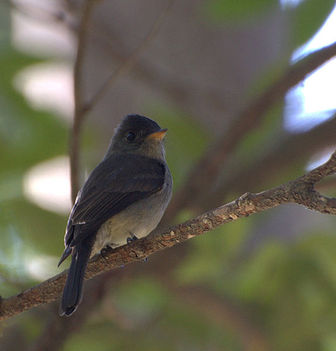Tropical Pewee
This pewee is found at the edges of forests and cultivated areas with tall trees. The nest is a small open saucer of fibre and grasses, lined with grass and decorated with lichen on its exterior. It is placed in a tree fork or on a branch. The female builds the nest and incubates the typical clutch of two creamy-white eggs, which are marked with red-brown spots at the larger end, for 15-16 days to hatching.

Original source: Dario SanchesPermission(Reusing this file)This image, which was originally posted to Flickr.com, was uploaded to Commons using Flickr upload bot on 11:36, 17 August 2008 (UTC) by Snowmanradio (talk). On that date it was licensed under the license below. This file is licensed under the Creative Commons Attribution-Share Alike 2.0 Generic license.You are free:to share – to copy, distribute and transmit the work
Author: Dario SanchesPermission(Reusing this file)This image, which was originally posted to Flickr.com, was uploaded to Commons using Flickr upload bot on 11:36, 17 August 2008 (UTC) by Snowmanradio (talk). On that date it was licensed under the license below. This file is licensed under the Creative Commons Attribution-Share Alike 2.0 Generic license.You are free:to share – to copy, distribute and transmit the work
The Tropical Pewee is classified as Least Concern. Does not qualify for a more at risk category. Widespread and abundant taxa are included in this category.
The Tropical Pewee, Contopus cinereus, is a small passerine bird in the tyrant flycatcher family. It breeds from southern Mexico and Trinidad south to Bolivia and Argentina. The taxon punensis, found in south-western Ecuador and western Peru, is usually included as a subspecies of the Tropical Pewee, but it has been suggested it should be considered a separate species, the Tumbes Pewee, Contopus punensis. This pewee is found at the edges of forests and cultivated areas with tall trees. More
The Tropical Pewee is 14 cm long and weighs 12 g. The upperparts are dark brown with a blackish crown and two whitish wing bars. The throat and centre of the breast are whitish, the abdomen is pale yellow, and the sides of the flanks and breast are grey-brown. The bill is short, with a black upper beak and an orange lower beak. Sexes are similar. More
Tropical Pewee determination Similar species Tyrannidae Amazonian Royal Flycatcher | Bearded Tachuri | Black-capped Becard | Black-chested Tyrant | Black-crowned Tityra | Black-tailed Tityra | Boat-billed Flycatcher | Boat-billed Tody-Tyrant | Bran-coloured Flycatcher | Brown-crested Flycatcher | Cinereous Becard | Cinereous Mourner | Cinnamon Attila | Cinnamon-crested Spadebill | Cliff Flycatcher | Common Tody-Flycatcher | Double-banded Pygmy-tyrant | Drab Water-Tyrant More
Tropical Pewee, and the migrant Eastern Pewee, who passes through at this time of year heading toward wintering grounds in South America. So: Tropical or Eastern? These two pewees have very different voices, so that's the main distinguishing feature if they're singing, which this one was not. Howell says that after the voices the thing to look for is that Tropical Pewees have "shorter primary projections" - the wings' primary feathers extend a relatively shorter distance beyond the secondary feathers than the Eastern's. More
Tropical Pewees perch on a high watchpoint from which they sally forth to catch flying insects, returning to the same exposed perch. This is a conspicuous species, with a trilled threeee call, or a sharp weet. There are, however, some geographical variations in its voice. It will defend the nest aggressively against species as large as a Great Kiskadee. More
Family : Tyrannidae
Genus : Contopus
Species : cinereus
Authority : (Spix, 1825)

